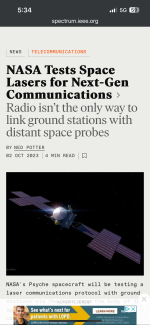LPF Donation via Stripe | LPF Donation - Other Methods
Links below open in new window
ArcticMyst Security by Avery

You are using an out of date browser. It may not display this or other websites correctly.
You should upgrade or use an alternative browser.
You should upgrade or use an alternative browser.
How do you guys feel about lasers being used for space communication?
- Thread starter IceBucket
- Start date



- Joined
- Sep 4, 2020
- Messages
- 1,462
- Points
- 113
I wonder what distance they hope to reach. Even the most controlled beam will diverge over distance.
"NASA has successfully tested a laser-based communication method that sent data over 16 million kilometers."
From:
https://learningenglish.voanews.com...-from-16-million-kilometers-away/7366203.html
"The Psyche spacecraft was launched at the beginning of October to the asteroid of the same name, which orbits the Sun between Mars and Jupiter. It is fitted with the DSOC (Deep Space Optical Communications) system and exchanged data with the ground for the first time from a distance of nearly 10 million miles (16 million kilometers) away on Nov. 14"
From:
https://www.nasaspaceflight.com/2023/12/laser-communication/
From:
https://learningenglish.voanews.com...-from-16-million-kilometers-away/7366203.html
"The Psyche spacecraft was launched at the beginning of October to the asteroid of the same name, which orbits the Sun between Mars and Jupiter. It is fitted with the DSOC (Deep Space Optical Communications) system and exchanged data with the ground for the first time from a distance of nearly 10 million miles (16 million kilometers) away on Nov. 14"
From:
https://www.nasaspaceflight.com/2023/12/laser-communication/
- Joined
- Oct 18, 2013
- Messages
- 931
- Points
- 83
With good filtering and a sensitive receiver/detector, probably can get decent results. They can reliably bounce a laser off the moon and back and detect that handful of photons that make it back to the detector after all.I wonder what distance they hope to reach. Even the most controlled beam will diverge over distance.
Eidetical
Active member
- Joined
- May 14, 2022
- Messages
- 201
- Points
- 43
I recently made some hologram optical elements that worked at 1550nm for laser communication system use. It was to allow for rapid characterization of beam distortions via the parallel processing done by the HOE, so an adaptive optics system could undistort it. The HOEs were looking good but the project apparently went a different direction. Communication by free space laser beam will provide good career long jobs for people in high school now.
- Joined
- Sep 20, 2013
- Messages
- 17,462
- Points
- 113
The moon is less than a quarter million miles away. They placed reflectors that only get a photon or maybe a few back at that less than half a million mile distance. For far space travel radio waves are a better option.With good filtering and a sensitive receiver/detector, probably can get decent results. They can reliably bounce a laser off the moon and back and detect that handful of photons that make it back to the detector after all.
kecked
0
- Joined
- Jun 18, 2012
- Messages
- 952
- Points
- 63
Well apparently it works since they got 14 million miles. Remember radio waves spread out too. Lasers spread slower.and from what I understand they can make the communication so only people in like a mile on the ground can receive the signal for security. They also encode the signal so they have amazing error correction. If you take say a high quality opsl and put that through say a 200:1 beam expander that beam could be sub microradian so the divergence could be extremely low. With proper coding you don’t need a lot of signal to receive it.
- Joined
- Sep 20, 2013
- Messages
- 17,462
- Points
- 113
There are certainly a lot of radio telescopes around looking for that intelligent life somewhere among the stars.
- Joined
- Sep 16, 2007
- Messages
- 3,658
- Points
- 113
A laser behaves like a point source of light, so its intensity will decrease according to the inverse square law (ignoring scattering, diffraction, absorption, etc.) just like radio waves will. At these astronomical distances, I think it's fair to also treat a radio transmitter as a point source. So with regard to the proportional decrease in intensity as distance increases, there is no difference.Well apparently it works since they got 14 million miles. Remember radio waves spread out too. Lasers spread slower.and from what I understand they can make the communication so only people in like a mile on the ground can receive the signal for security. They also encode the signal so they have amazing error correction. If you take say a high quality opsl and put that through say a 200:1 beam expander that beam could be sub microradian so the divergence could be extremely low. With proper coding you don’t need a lot of signal to receive it.
The difference is that (in the real world) with lasers we can achieve greater efficiency because the properties of laser light allow us to put a greater proportion of the total output energy on target - with the help of inherently lower divergence of visible or infrared versus radio beams. This means we can achieve a better signal-to-noise ratio with the same output power from a laser than a radio transmitter.
So even if your radio transmitter is more efficient in absolute terms, you may be able to achieve higher practical efficiency due to the increased intensity of the laser beam over the same distance.
Disclaimer: I'm a biologist, not a physicist.
kecked
0
- Joined
- Jun 18, 2012
- Messages
- 952
- Points
- 63
And a higher bit rate due to the carrier frequency



